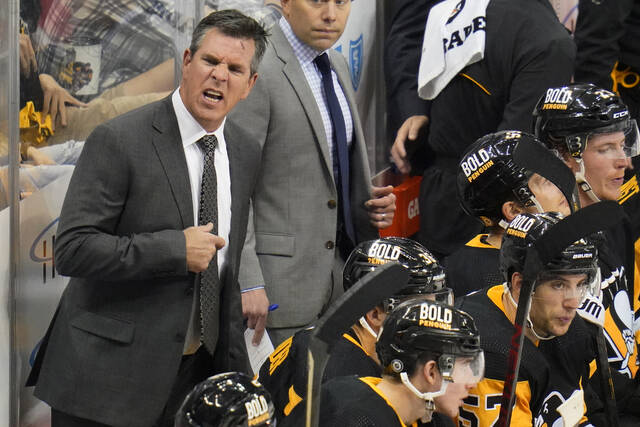Penguins look dominant on penalty kill
Tristan Jarry was credited with the win during the Penguins’ 2-0 road victory against the Toronto Maple Leafs on Saturday. His 26 saves earned him that triumph.
And Jake Guentzel scored the winning goal. An insurance tally by Jeff Carter helped secure the result.
But in many ways, the Penguins penalty kill was primarily responsible for Saturday’s outcome.
After Penguins forward Jason Zucker took a tripping penalty at 14 minutes, 47 seconds of the third period, Penguins forward Zach Aston-Reese doubled the Penguins’ trouble by incurring another tripping minor 11 seconds later.
That meant the Penguins had to kill a five-on-three situation for a daunting 1:48 late in the contest.
In total, there were three shots on net during that sequence. And two of them came from the Penguins.
Limiting the talented Maple Leafs to one shot during that vital juncture, the Penguins showed why they have the NHL’s best penalty kill. Entering Monday’s road game against the Winnipeg Jets, the Penguins are killing off 89.1% of opponents’ power plays.
This season’s success has come in stark contrast to the penalty-killing struggles in 2020-21. Last season, they had a conversion rate of only 77.4%, 27th out of 31 teams (Seattle joined the league this season).
A greater level of familiarity with second-year assistant coach Mike Vellucci, who oversees the penalty kill, has been cited as an overwhelming factor in that improvement.
“We’re kind of more on the same page,” Penguins forward Teddy Blueger said to media in Winnipeg. “We’re more in tune on the same wavelength when we pressure and stuff. Just making better reads off of each other. Last year was (Vellucci’s) first year, and I think maybe it took a little bit of time to figure out, what exactly we were supposed to do. Now, obviously, we’ve had some time to do that. Now that we’ve had that, just making better reads off each other, good communication, a commitment to blocking shots, getting pucks, being hard on the other team, kind of all those details adding up.”
Vellucci appears to be open to suggestions from the penalty killers, as well.
“He’s just very approachable,” said Blueger, who led all Penguins forwards with an average of 2:18 of average short-handed ice time per game before Monday. “All the guys feel comfortable asking questions or if there’s something that we think we can adjust from what we see on the ice, it’s easy to kind of go back and talk to him, work it out that way. As far as his philosophy, a big thing is aggression. Obviously, we’re short a guy so you’ve got to pick your spots. But it is important to pressure, even if you don’t necessarily get the puck, but just to kind of disrupt the rhythm, disrupt the other team’s momentum.”
Sullivan’s outlook on the Olympics
With games in Toronto and Winnipeg to conclude their three-game road trip through Canada, Penguins coach Mike Sullivan has fielded multiple questions about his role as head coach of the U.S. Olympic men’s team for the upcoming Olympic games in Beijing. A handful of prominent U.S.-born players play for the Maple Leafs and Winnipeg, such as forward Auston Matthews and goaltender Jack Campbell of Toronto as well as forward Kyle Connor and goaltender Connor Hellebuyck of Winnipeg.
Given his role in crafting the roster, Sullivan has been asked by local media on his assessment of specific American players in their respective markets.
On Monday, Sullivan noted his role in that process is more nuanced than simply selecting the most talented players.
“We’re trying to build a team in the truest sense of the word and not just an All-Star team,” Sullivan said. “We have to understand that we need penalty killers, we need guys that can win faceoffs, we need guys that are good on the wall, we need guys that are hard to play against. And we need players that score goals and generate offense and run a power play and things of that nature.
“It takes a lot of different aspects on both sides of the puck to create a team in the truest sense of the word that is competitive. So it’s going to take different types of players. We’re looking at that very closely. The other aspect that we’re looking at is just versatility. The ability to move people around and move people up the lineup depending on what the needs of the team are on any particular time.
“Those are just some of the things that we’ve talked about behind the scenes. We have a lot of good players. I would anticipate some really difficult decisions.”
Seth Rorabaugh is a TribLive reporter covering the Pittsburgh Penguins. A North Huntingdon native, he joined the Trib in 2019 and has covered the Penguins since 2007. He can be reached at srorabaugh@triblive.com.
Remove the ads from your TribLIVE reading experience but still support the journalists who create the content with TribLIVE Ad-Free.


